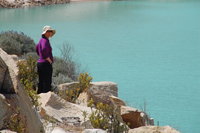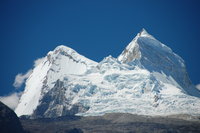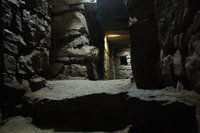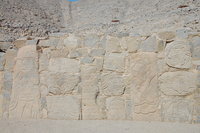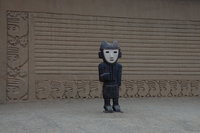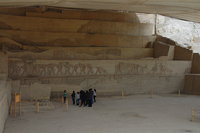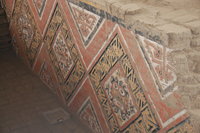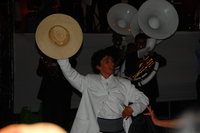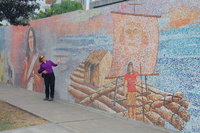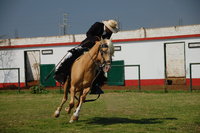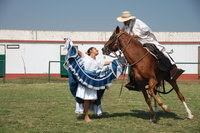We left Machu Picchu, Cusco and the Incas behind rather reluctantly, having enjoyed our time there. A brief overnight in Lima left us not really wanting to spend any time in that city (noisy, dirty, overcast), but we do have to come back later for reasons that will be explained in a future posting.
We caught a bus heading north (always a good thing) to a place called Huaraz which is deep in the Cordillera Blanca; the highest range of mountains in the world. It obviously doesn't contain the highest mountain, but it is consistently higher than the Himalayas. It has 16 peaks over 6000m and 267 glaciers (currently).
We found Huaraz to be a pretty dismal sort of place. It is where trekkers come to drink beer and brag about how many days they went without a wash, and the locals have a pretty cynical attitude related to parting gringos from their money. We quickly moved on to the sister town called Caraz which is sandwiched between the Cordilleras Blanca and Negra. It is a much more pleasant place to be (even if both restaurants are closed on a Monday) and slightly easier to pronounce.
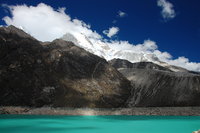
We were heading north to check out the pre-Inca ruins from civilisations dating back to 3000BC, but we thought it would be rude not to take a look at the mountains whilst we were here. We chose to visit what is considered the most beautiful of the glacial lakes called Laguna Parón, which is deep into the mountains at an altitude of around 4200m. It is also the largest lake in the Cordilleras. Being formed of glacial melt water, it is a deep aquamarine colour (and also pretty cold). It's only a 6 mile walk along the side of the lake, but that walk reveals some pretty spectacular views of the mountains. This was one of our last high altitude trips and we were quite pleased with the way we could now yomp off at over 4000m without giving it a second thought. Of course, as soon as we head down to the coast, all that hard-earned altitude acclimatisation will begin to fade.
An additional trek out of Caraz climbed up the side of the valley to reveal yet more spectacular views of the Cordilleras (both Blanca amd Negra). At this time of year, the sun tends to shine all day, every day, so the snow is either in retreat or sliding off the mountains! It also makes for some hot and dusty trails. Of course, had we come in the Peruvian summer, then it would have been overcast and raining, which would have been no fun.
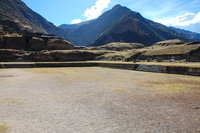
Our first pre-Incan ruin-fest was a visit to the heart of the Chavín empire. The word "chav" did not exist 3200 years ago when this society was just getting going otherwise surely they would have chosen another name! However, in a strange twist, the word "chavo" can mean "lad" in Spanish.
Chavín de Huántar is located on the opposite side of the Cordillera Blanca. For us this meant a 4 hour bus journey, for the Chavín it meant an ideal location between coast and jungle. Even though they chose a pretty dubious name, they did manage to set up quite a sophisticated society that stretched the length of Peru. However, the site at Chavín de Huántar was always the most important and was used as a ritual, ceremonial and political center.
One thing the Chavín excelled at was forming cults and indoctrinating people into them using psychedelic drugs, such as the San Pedro cactus. To this end, they built labyrinths under their city populated with weird carvings into which the priests would send initiates whilst under the influence. The priests could control the sound and light within the passageways using mirrors and horns which they probably used to influence those under the influence (got it?). It is not difficult to see, even today, how this could have been very effective in lending god-like powers to the priests. Way to go Chavs!
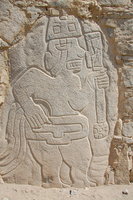
Post-Caraz, we left the mountains and headed for the coastal town of Casma. Since we were sandwiched between the Cordilleras Blanca and Negra, we had to cross the latter to get to the sea. The bus took us up and over the Callán Pass at about 4600m. The journey revealed spectacular views of the Blanca as we ascended the Negra. We then dropped all the way down the other side to sea level on one of those ridiculous roads with a million hairpins as it descends near vertical mountain faces. It is worth explaining that Peruvian buses have a windowed dividing wall between the driver and passengers with a locked door. The locked door is presumably to stop panicking passengers escaping. The [closed] curtains across the windows are to stop the panic in the first place as they obscure the crazy overtaking manoeuvres and vertiginous drops beneath the wheels!
Feeling blasé about having survived the plunge down to the coast and giddy on the oxygen-rich air, we hired some dude in a three-wheeled motorcycle taxi to take us to the ruins of Sechín outside the town of Casma. Normally, this would not be worth mentioning, but Casma and Sechín both lie on the Pan-American highway which runs the length of South America. So, we did battle with huge road-trains in our little rickshaw!
Sechín is one of the most important archaeological sites in Peru. It was built by some little-known bunch of ancients about 1600BC. In fact, pretty much all that is known about them is that they liked fighting and cutting out people's innards. The site today is not particularly accessible as it is still being excavated although curiously, the photos in the museum from the 1980s look identical to the state of the site today and there is certainly no sign of any work being done!
The major feature here is the 4m high walls surrounding the site that are covered in carvings of semi-naked fellows fighting and cutting out each others innards (told you). It is remarkable to see these carvings still in excellent condition after 3600 years. They were buried for most of this time, which explains their extraordinary state of preservation. Of course, now they are not, which explains their extraordinary state of deterioration. Way to go archaeologists!
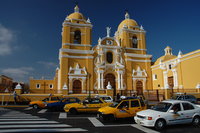
Another death-defying hurtle up the Panamerican Highway (that's what you get for using a bus company called "Eric the Red") put us in the city of Trujillo. Finally, another city with some intact colonial buildings; it survived most of the earthquakes that destroyed many other cities in this region. Trujillo is fiercely independent (it actually announced independence from the Spaniards a year before the rest of the country). An ideal place to spend July 28th which is Peruvian Independence Day. Trujillo is billed as having the cleanest square in all of Peru. Sadly, it is not one of the quietest. The taxi drivers here have developed a novel system of work whereby they attempt to solicit customers by blowing their horn at a potential passenger rather than the person who actually wants a taxi indicating such to a passing driver. This means that every taxi blows its horn at every person on the pavement. Couple this with the fact that there are about 10 taxis to every private vehicle and there is a cacophony of constant horn blowing. Additionally, every driver feels compelled to blow their horn as soon as the red traffic light begins to fade. They spoil an otherwise beautiful city. This inconsiderate and pointless nature manifests itself in virtually all aspects of Peruvian life (they slam doors for a pastime here). In a sense, Trujillo counts as a ruin since the locals ruin it!
Be that as it may, we came here for the festival and also to visit some more ruins. We checked in to a decent hotel for a change, but had to change rooms three times for an assortment reasons including the fact that the combined might of the hotel staff could not figure out that the hot water thermostat was so high, the boiling of the hot water woke everyone up at 7am. We eventually found a working room where the boiling was merely a faint rumble, but it was exposed to all the street noise and nightclubs in town instead. A karaoke version of "It's a Kind of Magic" at 4am by a non-English speaker is no fun!
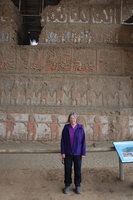
We came to visit the ruins of Chan Chan. Built by the Chimú and inhabited by them until they were trounced by Tupac Inca Yupanqui in the late 1400s, it is the largest pre-Columbian city in the Americas and the largest Adobe city in the world - or rather it was! It lay covered with sand for hundreds of years until it was excavated. Then along came el Niño in 1998 and washed nearly all of it away. What is left is very impressive, but will not be there much longer. The UN gave millions of dollars to aid in the preservation of the site. Inevitably, when they came to see what had been done with the money, they found that the answer was absolutely nothing. Needless to say, all the money had gone. The UN donated no more and the site is dissolving rapidly. Part of the problem is that it never rains here...until it does.
We also visited the Huaca Cao Viejo which is the Moche pyramid complex where a completely mummified female body was found in 2006 together with large quantities of gold, silver and ceremonial objects. She is estimated to be about 1500 years old and was preserved so well that her tattoos still show on her skin. It is thought she was the leader of the Moche people who died in childbirth. Rather surprisingly, she is still preserved quite well in a purpose-built, on-site museum. The Moche pre-date the Incas and were much more successful. They reigned from around 200AD to around 800AD and pre-dated the Chan Chan characters too.
One more site we went to is called Huaca de la Luna (Pyramid of the Moon). This is more than 700 years older than Chan Chan being built around 600AD and is also Moche. It is an impressive pyramidal structure with sacrificial altars, burial grounds and no end of pottery (to Megan's pleasure). There is an excellent and very informative museum that explains all aspects of the complex. Once outside and exploring the site, there are many information boards spread around. All of them contain lots of information about what excellent conservation work is being done here. Needless to say, the site was built with adobe bricks which, now they are exposed to the weather are eroding rapidly! To be fair, a roof has been constructed over the majority of the pyramid, but that really just obscures the view of what would otherwise be a magnificently impressive structure, Still, the coloured stucco murals are original, even the colouring which is quite something.
This ruin stuff is all very well if you're interested in that sort of thing, but we thought it was time we partook of the independence celebrations...
A large stage had been set up in the main square in Trujillo and from time to time we popped down there to see what was going on. At about 4pm on the eve of independence day, a man with a microphone started shouting. He continued to shout until about 7pm when a few fat children attempted to demonstrate the local dancing known as Marinera, which involves waving a handkerchief around. At about 9pm, the headline band appeared. It was quite difficult to know if they were any good since the ensuing onslaught of impossibly loud noise led us to seek refuge at the other side of the square where the bleeding finally stopped. The band had lots of people singing and playing bongos and might have been quite good had they not been trying to rival Hiroshima in volume!
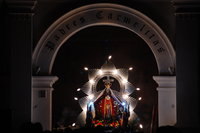
We had expected the square to be rammed with people and be quite riotous since Trujillo was the epicentre of all thing independence. However, there was a smattering of largely uninterested people (mostly older) hanging around. It seems as though the country persists in celebrating its independence even though no one really cares any more; certainly not the youth, who have moved with the times and no longer relate to the fusty old dignitaries banging on about the glorious fatherland. Perhaps they think things could have been different. Perhaps they just prefer YouTube. Enlightening none the less.
What did generate some interest was a ritual that took place on the evening of 28th which is the actual independence day. Here, the Virgin (model thereof) was taken from the Iglesia de San Francisco and paraded around town. Presumably, there is some deep Catholic meaning behind this ceremony but, for us, it was a chance to see a large amount of drum banging and dancing by numerous people in costumes. The parade came out of the church, went once around the main square and returned to the church. After a while, we had seen enough and went off to eat. When we returned, they were still going! Upon arriving back at the church, fireworks were let off and the drumming and dancing intensified. Goodness knows how long it went on.
We mopped up a couple more sights in town. The University has a mural around the campus that claims to be the largest in the world (of course). On one side it depicts the development of Peru through the ages and provides a succinct reminder of the various peoples (Moche, Chimú, Inca, etc) neatly placed in order. This was very well done. The other side depicts the landscapes, flora and fauna of the country and this was rubbish. Megan also wanted to go and see some Peruvian horses doing some weird kind of prancing. So we did.
This episode has probably been a little dry, but one of the reasons we came to Peru, and the north in particular, was to see some of the pre-Incan ruins. The Incas get all the publicity as far as Peru is concerned, but actually they weren't around for very long and were pretty backward for the times. They are only famous as they happened to be sitting around with all the gold when the Spaniards arrived and took it from them.
We spent nearly a week in Trujillo soaking up the ambience (and boiling water) and resting a little. Now we are leaving Trujillo and pushing on further north on much less travelled routes in search of some of the less visited pre-Incan sites. If we manage to amass enough moderately interesting stuff, there should be another instalment before we start heading south back towards Lima for the final sector of the trip.
